Patan, also known as Lalitpur, truly deserves to be called the “City of the Arts”. It has numerous skilled craftsmen, and it is obviously impossible to include them all in one feature. Nevertheless, here are some of the better known masters of Lalitpur.
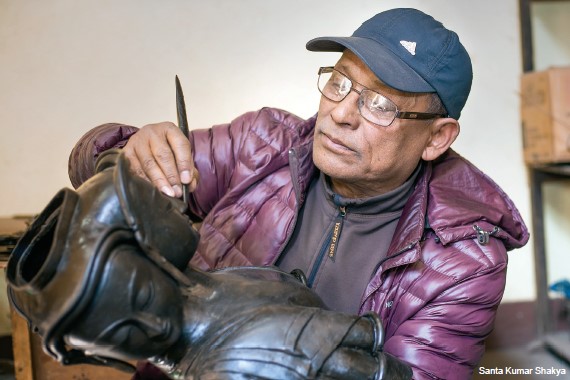
Patan Durbar Square, besides being a UNESCO-designated World Heritage Site monument zone, is also famous as a square having the most diverse styles of architecture contained in a square of its size anywhere in the world. One could say something on similar lines about some localities in this ‘City of the Arts’. Take Okubahal, for example—this historical locality perhaps has the most craftsmen working on metal in an area its size anywhere in the world. And, it is not ordinary craftsmen that I’m talking about. The area has a significant number of those who have earned the laureate of ‘master craftsman’.
Mr. Santa Kumar Shakya, recipient of the ‘Best Artist” award from the Federation of Handicraft Associations (FHAN) in 2072 B.S., is one such master. Famous for his magnificent statues of Sahasra-bhuja Sahasra-netra (Thousand-Armed, Thousand-Eyed Avalokitesvara), he is today one of Nepal’s leading metal sculptors. His works can be seen in some prominent places like Seto Gumba, Sigal, Kapan Monastery, Swaymbhu, and so on. One of his biggest creations, an 18-ft-tall statue, is located in the Ani nunnery some way below Kapan Monastery. Of course, you can also visit his workshop on the ground floor of his home, which is situated around the large courtyard behind Rudravarna Mahavihar, one of Lalitpur’s most beautiful heritages, an outstanding example of Newari art and architecture. Looking at the serene surrounding, and then at the beautiful pieces of art in the workshop, one cannot but say that they complement each other perfectly.
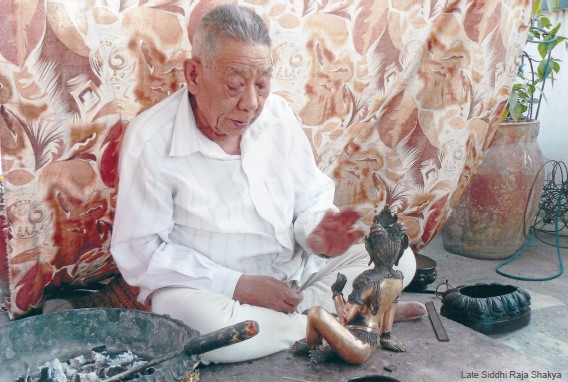
Okubahal is also home to another illustrious metal-sculpting family, that of the legendary Siddhi Raja Shakya, whose sons are now enthusiastically continuing the tradition and upholding the master’s proud legacy. Siddhi Raja’s father, Punya Raja Shakya, was also a sculptor who sculpted impressive statues in copper, brass, silver, gold, pancha dhatu (amalgamation of five metals), and astha dhatu (amalgamation of eight metals). The statues they make are of Buddha and his incarnations, along with other Buddhist deities, and they are made exclusively for monasteries all over the country and abroad. It is interesting to note that they are descendants of royal monks who were in charge of Rudravarna Mahavihar, the most important monastery in the area (that’s the reason for the honorific ‘Raja’ in their name). Siddhi Raja made twenty-one Bhagwati statues to adorn Hanumandhoka, and two lions for the erstwhile Narayanhiti royal palace, along with a Mayadevi and Chintamani Lokeswar statue. Although their statues are generally 14 to 18 inches tall, some really large ones have also been made, one of the largest being a six-and-half feet statue of Shakyamuni for a monastery in Lumbini.
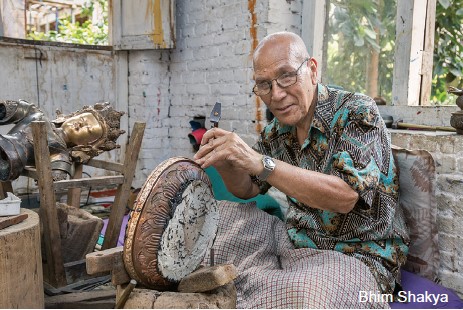
However, when talking about large statues, one cannot top the achievements of Raj Kumar Shakya, another prominent metal sculptor of Okubahal, who recently shifted his workshop to Haatiban because of the damages to his ancestral home by the 2015 quake. He specializes in metal sheet embossing and making large-sized statues, as well as stupas, mandalas, and temples. He, or rather, one of his works, was in the limelight recently—a 155-ft-tall statue of Guru Padmasambhava in the eastern part of Bhutan, which was completed in March 20, 2014. It consists of 40-ft high pedestal, and the face alone is 15 ft in length. A total of 70,000 kg of copper was used in its making. Another of the master’s notable works is a 16-ft Bhumisparsha Buddha in Lumbini, and presently he is busy on another massive work, a 50-ft Siddhartha Buddha that will adorn the Ling Sang Temple, also in Lumbini. Raj Kumar was responsible for all the repousse work done in the Nepal pavilions at the World Expos in Hanover in 2000 and Shanghai in 2010. He is also a recipient of the “Best Artist of the Year” award by FHAN.
The above-mentioned examples should put to rest any doubt about Okubahal being a mine of metal sculptors. Yet, it would be negligent of this writer not to mention one more, that is, Kalu Kumale, who was born in Tha:pa of Okubahal to a family of traditional potters, but moved on to become one of the country’s greatest living metal sculptors. He is an octogenarian now, and his workshop is in Haatiban, and he is known famously as the “Angry Sculptor” due to his depictions of Megha Sambhar, a ferocious guardian deity having the head of a buffalo. His honorific title is in complete contrast with his deep humility and soft spoken personality. Not so his works: they are huge, and fairly shout out their imposing presence wherever they may be.
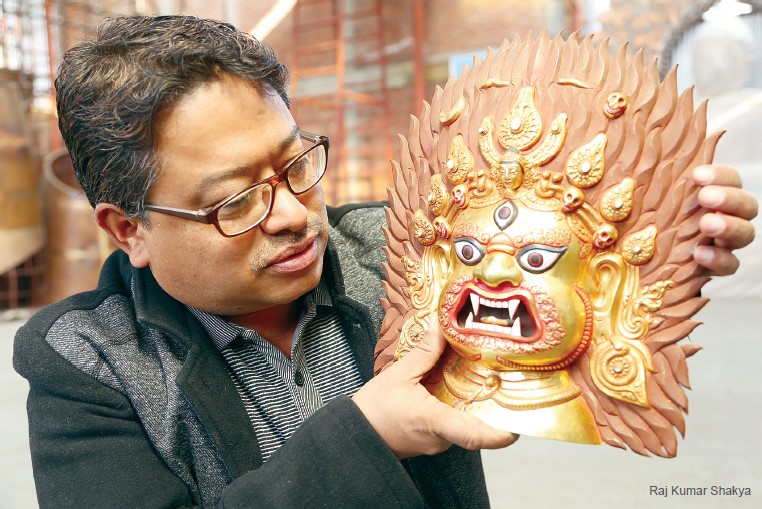 Obviously, metal craft is not the only art that artists of Lalitpur excel in, and of course, Okubahal is but one example of a city teeming with talent. Nevertheless, metal is a magnificent metal to work on, with such works never ceasing to impress. And, none more so than silver, in which another craftsman, also an octogenarian, is a master. His name is Chaitya Raj Shakya, and his workshop is in his home in Hariharbhawan, Lalitpur. The Federation of Handicraft Associations has honored him for his high skill in the art of silver filigree making with a golden plaque, as well as with the title of “Best Artist” in 2060 B.S. The master craftsman’s entire family, both men and women, is involved in the profession, and that’s as well, because they have standing orders that will keep them busy for at least the next couple of years! They do mostly customized works for contractual assignments from various parties, now almost totally from China. Look East, young man—wasn’t that what they used to say ages ago?
Obviously, metal craft is not the only art that artists of Lalitpur excel in, and of course, Okubahal is but one example of a city teeming with talent. Nevertheless, metal is a magnificent metal to work on, with such works never ceasing to impress. And, none more so than silver, in which another craftsman, also an octogenarian, is a master. His name is Chaitya Raj Shakya, and his workshop is in his home in Hariharbhawan, Lalitpur. The Federation of Handicraft Associations has honored him for his high skill in the art of silver filigree making with a golden plaque, as well as with the title of “Best Artist” in 2060 B.S. The master craftsman’s entire family, both men and women, is involved in the profession, and that’s as well, because they have standing orders that will keep them busy for at least the next couple of years! They do mostly customized works for contractual assignments from various parties, now almost totally from China. Look East, young man—wasn’t that what they used to say ages ago?
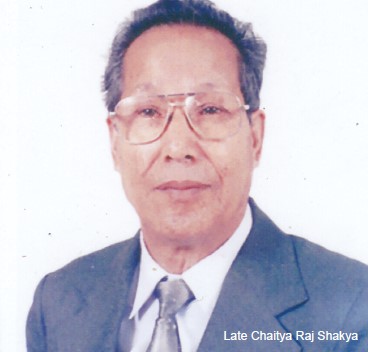 Now, let’s go to a place called Kani Bahal in Patan, which is some distance from Okubahal. Here’s where one will find a collection of brass “Buddha Face”s hanging on the walls and on the mantle of the sitting room of a modest house. They may look like simple works, but look closer, and you’ll find a high degree of artistry in the way each face has been sculpted. Verily, the works of a master—the master being no other than Mahendra Ratna Shakya, who was recognized as “Best Artist” by FHAN in 2005/2006. He is also an academic of sorts, having taught for four years in Kathmandu University’s Department of South Asian Art. He laments the fact that there is no academy for traditional art in the country, and believes that it is the necessity of special tools and other paraphernalia for traditional art work that is the major problem. He is also of the opinion that, since metal sculpting is a time-consuming and costly affair, it is difficult to get art students interested in pursuing the craft. In this context, it is a relief to know that most of the master craftsmen’s families are into their traditional vocations in Patan, Lalitpur; otherwise we would be losing a valuable part of our proud culture.
Now, let’s go to a place called Kani Bahal in Patan, which is some distance from Okubahal. Here’s where one will find a collection of brass “Buddha Face”s hanging on the walls and on the mantle of the sitting room of a modest house. They may look like simple works, but look closer, and you’ll find a high degree of artistry in the way each face has been sculpted. Verily, the works of a master—the master being no other than Mahendra Ratna Shakya, who was recognized as “Best Artist” by FHAN in 2005/2006. He is also an academic of sorts, having taught for four years in Kathmandu University’s Department of South Asian Art. He laments the fact that there is no academy for traditional art in the country, and believes that it is the necessity of special tools and other paraphernalia for traditional art work that is the major problem. He is also of the opinion that, since metal sculpting is a time-consuming and costly affair, it is difficult to get art students interested in pursuing the craft. In this context, it is a relief to know that most of the master craftsmen’s families are into their traditional vocations in Patan, Lalitpur; otherwise we would be losing a valuable part of our proud culture.
In this context, it is also a relief to know that some of the master craftsmen of Patan are teaching their craft at various training centers, with some like Prachanda Man Shakya, in fact, founding one themselves; in his case, the Nepal Traditional Handicrafts Training Center, which is located just below the Akheswor Mahavihar in Pulchowk. A master in repousse art, he has won the “Best Artist” award from FHAN, and taught more than 600 students till now in all aspects of traditional art and craft. The center is perhaps the only center teaching repousse art here. He himself is an artist and designer of traditional painting, aside from being a repousse artist, who has been involved in many restoration and renovation works in and around Lalitpur, including painting of the country’s biggest pau:bha in the 1200-year-old Golden Temple near Patan Durbar Square. He is also well-known for painting many famous mandalas for different festivals and celebrations.
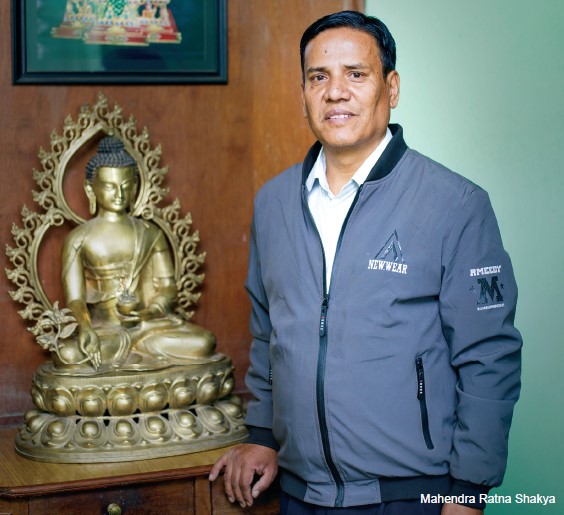 When talking about traditional painting, how can we not mention Lok Raj Chitrakar, who won the “Best Artist of the Year” award from FHAN in 1993? His place of work, Simrik Atelier, is located near Patan Gate, and this is also where he teaches the fine art of pau:bha painting to both local and foreign students. You’ll find some really beautiful paintings adorning the walls, and looking at them will leave you in no doubt that they are the works of a master artist. If you are fortunate enough to be a world traveler, and interested in pau:bha painting, then you’ll also find his works adorning some important museums and shrines, such as State Museum of Religion, St Petersburg, Russia, Mohatta Palace Museum, Karachi, Kemi Museum of Arts, Kemi, Finland, Fukuoka Asia Museum of Arts, Fukuoka, Japan, Kanzouin Mandala Art Museum, Tokyo, Yushoji Temple, Saitama, Japan, and Shinnyoen Temple, Ttachikawa, Japan.
When talking about traditional painting, how can we not mention Lok Raj Chitrakar, who won the “Best Artist of the Year” award from FHAN in 1993? His place of work, Simrik Atelier, is located near Patan Gate, and this is also where he teaches the fine art of pau:bha painting to both local and foreign students. You’ll find some really beautiful paintings adorning the walls, and looking at them will leave you in no doubt that they are the works of a master artist. If you are fortunate enough to be a world traveler, and interested in pau:bha painting, then you’ll also find his works adorning some important museums and shrines, such as State Museum of Religion, St Petersburg, Russia, Mohatta Palace Museum, Karachi, Kemi Museum of Arts, Kemi, Finland, Fukuoka Asia Museum of Arts, Fukuoka, Japan, Kanzouin Mandala Art Museum, Tokyo, Yushoji Temple, Saitama, Japan, and Shinnyoen Temple, Ttachikawa, Japan.
Now, from the soft to the hard, yes, I’m talking about stone craft. Patan is home to many talented sculptors working in stone. It is one of the toughest of the arts, no doubt, and you’ll realize this when you visit Arniko Stone Carving in Patan Industrial Estate, where master sculptor Dharma Raj Shakya has his workshop. His works are in high demand, and till date, he has made about 5,000 stone figures. Some of his works are huge pieces, such as the two lions at the entrance to Basantpur Durbar Square, which were carved from a single stone. Must have been a really massive stone! Other gigantic works of his are the 20-ft Jalsagar Narayan figure in Banepa, a 30-ft-tall stone Radhe Radhe Temple in Bhaktapur, and a life-sized statue of Sankhadhar Sakhwa in Thimi. The last time I was in his workshop, some one year or so ago, there was a mammoth Ganesh statue, and he was working on another monolith, a four-ton, 32-ft-tall statue of Shakyamuni Buddha that was assigned by a monastery in Mustang.
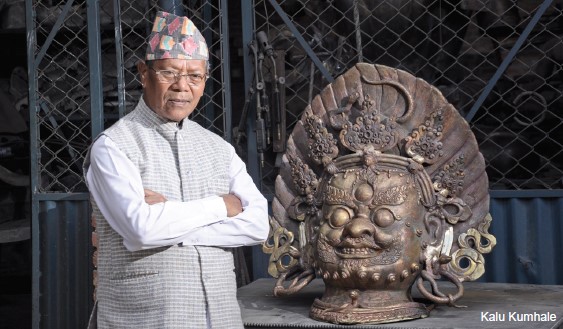 It is also in Patan that you’ll find Bhim Shakya, who lives in, yes, the very same Okubahal, that haven of metal sculptors. He is well past eighty, but still carries on doing what he knows best, in fact, is a master of—chiseling—an art that requires deep knowledge of iconography, and a hand that is as sure as a brain surgeon’s. One of his best works is a beautiful 15-inch figure of Padmasmbhava that was on display at a traditional art exhibition some years ago at the National Art Council. Colorfully rendered, the engravings are extremely well detailed, and one cannot but admire the painstaking work of chiseling that has gone into it. He has had a colorful life, as well. When 15, he took off for Lhasa, where he lived for eight years, becoming a monk in a gumba and learning about Tibetan Buddhism. A three-foot-tall stupa in Maitri Gumba of Swayambhu is one of his more conspicuous works, its size being also somewhat away from the norm, since it is the smaller figures that are more challenging to bring to life through the fine art of chiseling, and in which he clearly excels.
It is also in Patan that you’ll find Bhim Shakya, who lives in, yes, the very same Okubahal, that haven of metal sculptors. He is well past eighty, but still carries on doing what he knows best, in fact, is a master of—chiseling—an art that requires deep knowledge of iconography, and a hand that is as sure as a brain surgeon’s. One of his best works is a beautiful 15-inch figure of Padmasmbhava that was on display at a traditional art exhibition some years ago at the National Art Council. Colorfully rendered, the engravings are extremely well detailed, and one cannot but admire the painstaking work of chiseling that has gone into it. He has had a colorful life, as well. When 15, he took off for Lhasa, where he lived for eight years, becoming a monk in a gumba and learning about Tibetan Buddhism. A three-foot-tall stupa in Maitri Gumba of Swayambhu is one of his more conspicuous works, its size being also somewhat away from the norm, since it is the smaller figures that are more challenging to bring to life through the fine art of chiseling, and in which he clearly excels.
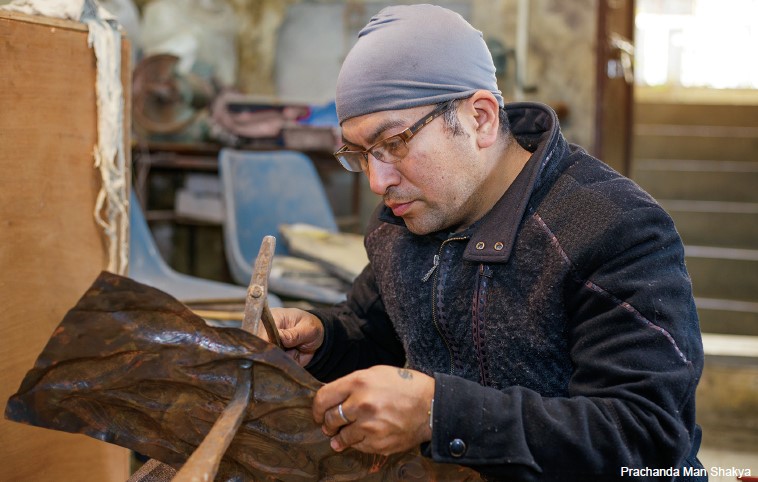
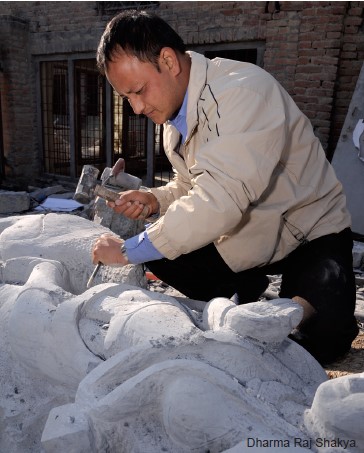 As mentioned at the outset, the “City of the Arts” has many more adept artists and craftsmen than those mentioned above, many of them following in their ancestors’ footsteps, and they all deserve our heartfelt gratitude and appreciation for giving valuable continuation to a part of the country’s culture that one can take great pride in. So, shall we say, “Viva la Lalitpur, viva la City of the Arts”?
As mentioned at the outset, the “City of the Arts” has many more adept artists and craftsmen than those mentioned above, many of them following in their ancestors’ footsteps, and they all deserve our heartfelt gratitude and appreciation for giving valuable continuation to a part of the country’s culture that one can take great pride in. So, shall we say, “Viva la Lalitpur, viva la City of the Arts”?









